

zetetic56
-
Posts
52 -
Joined
Content Type
Profiles
Forums
Events
Posts posted by zetetic56
-
-
16 hours ago, Genady said:
Where is a tube with different cross-sections?
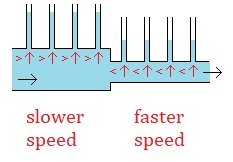
When a fluid goes from a tube with a larger cross-section into a tube with a smaller cross-section it speeds up.
In Wikipedia it says:
“Bernoulli's principle states that an increase in the speed of a fluid occurs simultaneously with a decrease in static pressure or the fluid's potential energy.”
And so, when a fluid goes from a larger tube to a smaller tube and speeds up there is also a “simultaneous ... decrease in static pressure or the fluid’s potential energy”.

In a wind-tunnel (or a water-tunnel) the fluid can be moved through it slowly or the fluid can be moved through it quickly. The cross-section of the tube can remain the same, while the fluid moving through it can move slower or faster. (And we can assume this is done in a way so that the density of the fluid moving at the two different speeds is the same (and so there is no change in pressure from a change in density (mass per unit volume)).)
And given that “Bernoulli's principle states that an increase in the speed of a fluid occurs simultaneously with a decrease in static pressure or the fluid's potential energy”,
This then means when a fluid in a tunnel with one consistent size cross-section is moved faster through that tunnel there is still a “simultaneous ... decrease in static pressure or the fluid’s potential energy”.
If I’m reading the Wikipedia Bernoulli quote right, then when we move fluid slower or faster through the one sized wind/water tunnel, if there are pressure gauges on the top of that tunnel, then the readings on these gauges will be more when the fluid is moving slower and the readings on the gauges will be less when the fluid is moving faster.
(?)

On the left, the fluid moving faster through the smaller part of the tube will put less pressure on the walls of the tube than the fluid moving through the larger part of the tube.
While, on the right, the same thing occurs, and the fluid moving faster through the tube will put less pressure on the walls of the tube than the fluid moving through the same tube slower.
“[A]n increase in the speed of a fluid occurs simultaneously with a decrease in static pressure or the fluid's potential energy.” And the “decrease in static pressure or the fluid’s potential energy” manifests as a decrease in the pressure from the fluid on the walls of the tube it is moving through.
(Or so I think.)
16 hours ago, Genady said:[T]he statement, "when there is movement of a fluid within a solid body there is less pressure on every point of the surface of the solid body from the fluid" is incorrect.
When a fluid is at rest and then is moving at some speed, this is an increase in speed (from 0 to something).
And so when a fluid is moving, as opposed to being at rest, there is “simultaneously ... a decrease in static pressure or the fluid’s potential energy”.

If we think of every point on the tube walls as potential pressure gauges, then “when there is movement of a fluid within a solid body there is less pressure on every point of the surface of the solid body from the fluid” seems to me to be correct.
But maybe I haven’t made my case, and maybe we still disagree. (And maybe I’m still getting something wrong.)
(?)
Thank you and cheers. : ) !!!
0 -
6 hours ago, zetetic56 said:
... the same lesser and greater pressures from the fluid would also be lesser and greater pressure on the the two fixed in place walls ...
5 hours ago, Genady said:This is correct. ... the pressure in two points of the same flow ...

We seem to agree that, just as with pressure gauges, that with fixed walls, that at a point in the smaller tube with the faster moving fluid there will be less pressure from the fluid on the fixed wall while at a point in the larger tube with the slower moving fluid there will be more pressure from the fluid on the fixed wall.

And so the same reasoning would lead to the idea that if we had several pressure gauges at several points then they would all show the lesser and greater amounts of pressures at each of these points, and so we would also have the same lesser and greater amounts of pressures at these same points with fixed walls instead of pressure gauges.
And taking this same logic a step further, we could theoretically have a pressure gauge at every possible point along the fixed walls of the tube and so we would have this same lesser and greater pressures at every point along the fixed walls of the tube themselves.
And so we end up with the logical conclusion: when there is movement of a fluid within a solid body there is less pressure on every point of the surface of the solid body from the fluid.
Yes? No?
5 hours ago, Genady said:... two different flow regimes ...

According to Google the definition of a “flow regime” is “essentially a description of the flow structure, or distribution of one fluid phase relative to the other” and is also referred to as a “flow pattern”.
So in the larger tube we have one “flow regime” and in the smaller tube we have a different “flow regime”. And if the velocities of the fluid moving through each of the two tube sections are constant and do not change with time, then we have two “steady state” “flow regimes”. (If i’m using these terms right.)
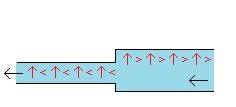
And so, if we think in terms of “flow regimes” then it seems like we’d end up with the idea that where two “flow regimes” are different in how fast the fluid moves along the solid boundary walls containing them then the faster the fluid moves the less the pressure from the fluid is on every point of that boundary wall. (Again, if I’m using these terms right.)
What do ya’ think? What am I still missing?
Thank you. : ) !!!
0 -

The two above pictures are from the Wikipedia page on the "Venturi Effect". The picture on the right is labeled as a "Venturi Meter".
In the drawing above on the right, the U shaped tube below the pipe is labeled as a "manometer".
And according to Google a "manometer" is defined as: "an instrument for measuring the pressure acting on a column of fluid, especially one with a U-shaped tube of liquid in which a difference in the pressures acting in the two arms of the tube causes the liquid to reach different heights in the two arms."
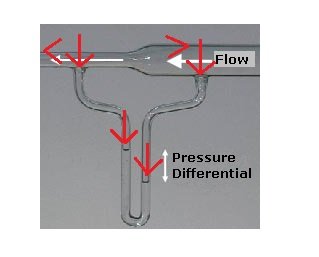
In that "manometer" there is one fluid (presumable air) pushing down on another fluid (presumable water). The lesser pressure from the fluid moving faster through the pipe and the greater pressure from that fluid moving slower through the pipe have an affect on the other fluid at the bottom of the U and shift it.
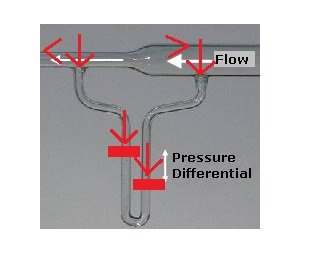
If there were two solid moveable walls resting on the top of the other fluid at the bottom of the pipe, my guess would be that we would get the same affect.
My guess is that the differences in pressures from the fluid would affect a solid they are in contact with just as much as they directly affected the another fluid before the walls were added.
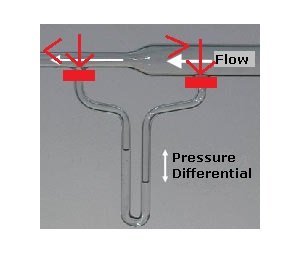
And if those moveable walls were moved to the top of the two ends of the "manometer" then I would expect that the lesser pressure in the faster moving fluid and the greater pressure in the slower moving fluid would also affect these solid moveable walls (now in line with the walls of the pipe that the fluid is flowing through).
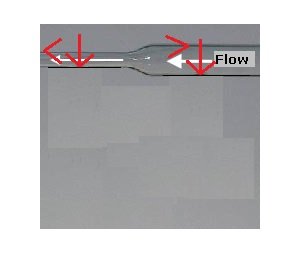
And so if we removed the "manometer" and fill in the two open ends where the tops of the "manometer" were with just solid walls, then the same lesser and greater pressures from the fluid would also be lesser and greater pressure on the the two fixed in place walls.
This is my reasoning and this is why I believe that when a fluid moves faster through a tube it puts less pressure on the tube's walls while when a fluid moves slower through a tube it puts more pressure on the tube's walls.
I think my logic is right, but perhaps there's some underlying piece of Physics that my uneducated self is missing. ( ? )
Thank you for reading this. : )
0 -
13 hours ago, Genady said:
However, I think that your common sense understanding of Bernoulli's principle is incorrect.
Maybe.
I understand from looking at, but not studying, the technical aspects of Bernoulli's Principle, that it appears to me there are different ways to think about it and there were probably some early Physics classic debates about it and there may be different technically important ways to understand it. And all of that is nothing that I know about or understand at all.
I think visually, and here is how I have understood and defined "Bernoulli's Principle" for myself.
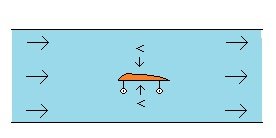
When fluid moves across the surface of a solid body, the pressure from the fluid on the body decreases. And the greater the movement the greater the decrease in pressure from the fluid on the body.
This is true when the fluid moves around the body.
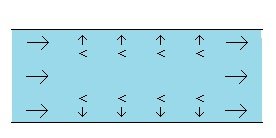
And this is true when the fluid moves through the body.
And the two things above are really just the same thing.
And maybe I'm wrong about this. This is how I've made the basic idea of Bernoulli's Principle make sense to me. And even if I'm not wrong about this (and maybe I am) I could still be using the term "Bernoulli's Principle" wrong (and perhaps I'm saying something different).
---
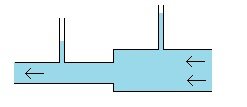
When water moves though a pipe with different sized sections, it is my understanding that the fluid will move slower in the larger sections and faster in the smaller sections, and it is my understanding that there is a decrease in pressure with the faster moving fluid, and it is my understanding that the pressure from the fluid on a pressure gauge will show this.
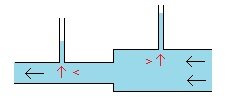
And so the lesser and greater pressures from the fluid do affect the pressure gauge and we get readings.
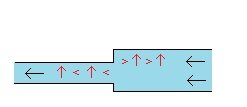
And I would expect if there was not a pressure gauge there but a wall that the same decrease in pressure from the moving fluid on the pressure gauge would also be the same decrease in pressure from the fluid on the wall at that exact same spot, as well as an equal decrease in pressure on all the points along the walls.
This is my reasoning.
This is why I think there is decreased pressure on the walls when the fluid moves along the walls.
But, maybe I've gotten far off base here and maybe I'm missing some fundamentals.
Thank you and take care. : ) !!!
---
2 hours ago, Ken Fabian said:Huh [?]
Where's my delete key?
Some times I find myself in metaphorical loose-orbit around the Moon. Apologies.
Thank you and take care. : ) !!!
0 -
33 minutes ago, Genady said:
Why not?
My common sense understanding of Bernoulli's Principle is when a solid moves through a fluid or when a fluid moves through a solid that there is a pressure decrease on that solid body from the fluid.
There are different ways of looking at a rising aircraft wing and one of those ways, I understand, is to look at the greater decrease in pressure pushing down on the top and the lesser decrease in pressure pushing up on the bottom due to the more round top and more flat bottom when the wing moves horizontally.
I don't know much about airplane wings, but if the fluid in the wind tunnel passing by the wing could pass by the wing without having a greater decrease in downward pressure and without having a lesser decrease in upward pressure, I cannot see the mechanics of this lack of an affect could occur.
The reason why I said "it makes no sense to me" is that I cannot see how a moving fluid on along solid could sometimes have an affect (one way of describing a rising airfoil) and could sometimes not have an affect (the circulating fluid moving along the moveable wall to the side). It seems like Bernoulli's Principle would either just work in each case or not work in each case. I can't see the logic to distinguish where Bernoulli's Principle of less pressure when the fluid is in motion has an affect on the solid from when it does not have an affect on the solid.
This is where my thinking is at.
Thank you. : ) !!!
0 -
23 minutes ago, Genady said:
No, I don't see why causing the fluid to move would decrease the pressure within the fluid. The Bernoulli's principle doesn't say so, AFAIK.
I didn't understand your use of terms "inside the flow" and "outside the flow". Apologies.
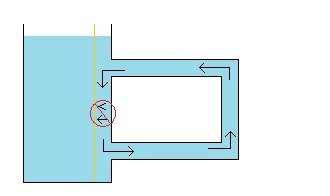
Are you saying that it is possible for the fluid to move relative to the wall and to not have a pressure decrease from the fluid on the wall?
I don't think that make sense.
But maybe there is something I'm missing and/or misunderstanding.
( ? )
Thanks. : ) !!!
0 -
1 hour ago, Genady said:
How it relates to the pressure outside the flow, is another question.
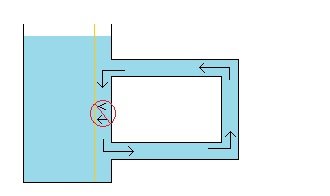
If I understand you correctly, you are saying that it is possible that when a fluid goes from being at rest inside a circular tube to being in motion, that while there is a decrease in pressure within the moving fluid, that it is possible that this decrease in pressure does not affect the pressure of the fluid on the solid wall that the fluid is moving relative to.
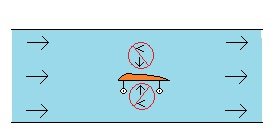
Then is it possible that if there is an airfoil in a wind tunnel that as the fluid moves over the top and bottom of the solid body that while there is a pressure decrease in the moving fluid itself that this pressure decrease does not affect the pressure of the fluid on the solid body of the airfoil that the fluid is moving relative to?
That doesn't sound right to me.
Or perhaps I did not understand your response?
Thank you. : ) !!!
0 -
On 6/8/2023 at 12:46 PM, Genady said:
"[T]he Bernoulli Principle, which states that the speed of a fluid (air, in this case) determines the amount of pressure that a fluid can exert." - nasa.gov
It is my understanding that when a solid body moves through a fluid and when a fluid moves through a solid body (a pipe), when there is relative motion, and if the solid and the fluid are in contract with one another, then this means the pressure from the fluid on the solid decreases (and the faster the relative motion the greater the decrease in pressure).
Your reasoning that there will be a pressure decrease on the right side of the wall as the fluid is moving relative to it, seems solid logic, given my basic understanding of Bernoulli's Principle, to me.
(?)
Thank you. : ) !!!
0 -
8 minutes ago, Genady said:
Yes, perhaps you better go back and find where this idea of the reduced pressure came from.
I did.
I thought we were in agreement about this, but maybe not.
On 6/8/2023 at 12:46 PM, Genady said:I thought we agreed, but maybe not.
8 minutes ago, Genady said:Regardless of the wall being vertical or horizontal, if the fluid moves by external force, this movement does not reduce the pressure.
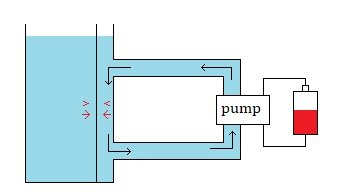
The force that circulates the fluid comes from the pump. Is this not "external"? There may be a technical definition of "extremal force" in Physics and I just need to learn the mechanics of this and how it works.
(?)
Thank you. : ) !!!
0 -
13 minutes ago, Genady said:
No, there is not. The rotating paddle wheel will circulate the water but will not decrease the pressure.
Hmmm?
These are the steps in my reasoning:
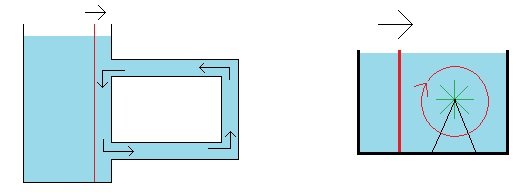
If the wall will move to the right when the fluid is circulating around in the pipe and so is moving relative to the wall, then I would think if the paddle wheel was immerse in a fluid in a cup where there is a movable side wall as well that the same logic would apply and the wall with the circulating fluid would also move to the right.
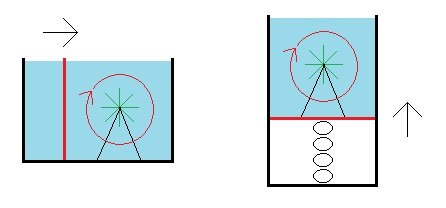
And if the side wall would move to the right when the fluid is moving relative to the wall and the pressure from the fluid decreases, then I would expect the same pressure decrease when the fluid moves relative to a moveable floor and so (my reasoning) is that the spring will decompress.
That's how I ended up where I am on this.
Perhaps there's some bit of Physics that I am missing here. Or perhaps I just don't understand the point.
Thank you for your time. : ) !!!
0 -
12 minutes ago, Genady said:
I think we can say any of that or something else, e.g., "the force is from the wall", - as long as we understand the mechanics of it.
If it makes sense to mechanically think of the force compressing the spring is from the downward pressure from the fluid, then
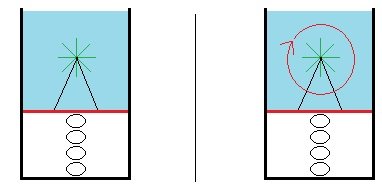
If there is a paddle wheel immersed in the water and fixed in place connected to the movable floor, and if we have two systems with the same thing, but in one system the water is not being circulated around inside the open topped cup while in the other system the water is being circulated around inside the open topped cup, and so there is a decrease in downward pressure in the one case and not this decrease in the other, then will the compressed spring be less compressed in the case where the fluid is moving?
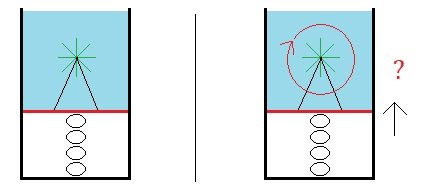
The area of the floor remains the same in both cases, but in the one case the amount of pressure pushing down on the floor decreases.
If it mechanically makes sense to think of the spring being compressed by the downward pressure in the fluid, then I would think that the spring will decompress in the case where the fluid is moving around.
(?)
What do ya' think?
Thank you and cheers. : ) !!!
0 -
12 minutes ago, Genady said:
The brief moment of the reduced pressure will last while the wall accelerates from the resting state to a constant velocity. When the velocity is constant, the pressure will return to be equal the weight of the fluid divided by the area of the wall, i.e., not reduced.
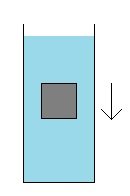
I think I understand what you're saying.
What I was thinking about was a case where the fluid's ability to flow upwards is in some way restricted. But maybe I just misunderstood the conversion you two were having. Or maybe such a restriction is irrelevant and I need some more Physics studying. : ) Apologies for weighing in and not adding to the conversation.
7 minutes ago, Genady said:We measure the downward pressure times the area and this is equal the weight, if the wall moves with a constant velocity.
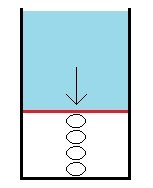
Thank you. Downward pressure (amount x area) is equal to the weight, cool, that makes sense. Weight and downward pressure are equal amounts.
What I'm wondering is this: There is a force pushing down on the spring. Would we say "this force is from the downward pressure from the fluid" or would we say "this force is from the gravitational attraction between the fluid and the Earth below"?
Thank you. : )
0 -
On 6/16/2023 at 7:10 PM, Ken Fabian said:
I still think what happens with an immersed piston in motion making positive pressure below is that the inverse happens above, like a piston working in reverse, lowering the pressure. Whilst the top of the vessel looks to be open the liquid is contained, by gravity and as long as the piston is moving/sinking the pressure above will be lowered and below will be raised.
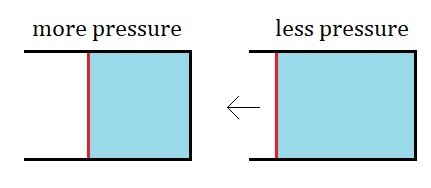
If gas is in a chamber and a wall is pulled out then there will be less pressure.
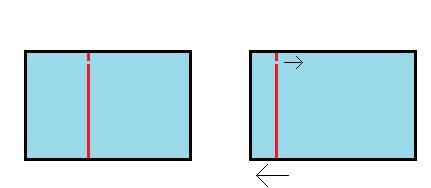
If there is a little hole in the moveable wall and if there is fluid on the other side of the wall, then since the fluid will not flow through the little hole and into the expanding chamber instantaneously, it will take a moment, it seems to me like for a moment (a very brief moment) there will be less pressure in the expanding chamber.
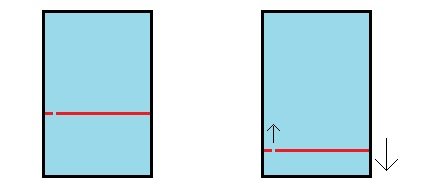
If I understand your point correctly you were thinking about something like this but falling due to gravity. (?)
If so, I think the same logic would hold, and there would be a brief moment of less pressure above the falling piston.
Well, that's my guess.
---
On 6/14/2023 at 11:50 AM, Genady said:BTW ...

This is my favorite perpetual motion machine. When I first saw it I thought it worked. But then I learned some basic physics and realized why it doesn't work.
There is a wheel resting on a central axis that it can rotate around. The wheel is half submerged in a fluid and is half outside the fluid.
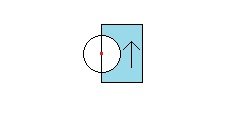
And so there is an upward buoyant force on one side of the wheel and not on the other.
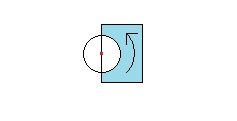
And so it seems like it will rotate counter clockwise and it will keep rotating forever.
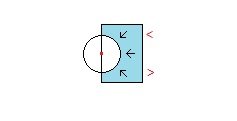
But then I learned some basic Physics and found out that the pressure from a fluid on a submerged body has direction and its direction is perpendicular to the surface of the body.
And so, while there is more pressure on the right half of the wheel at its bottom and less pressure on its top, all of this pressure, because this is a circle, is directed at the central axis. There is an overall upward buoyant force on the right side of this wheel, but there is no torque, there is no twisting force around the central axis.
And so, my favorite pmm does not work.
---
Question:
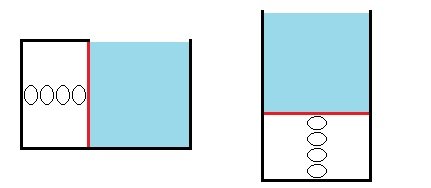
On the left, there is a open topped container filled with a fluid and it has a moveable wall on its side. On the other side of the moveable wall is a compressible spring.
I think in the left case we would say where are measuring the "pressure" of the fluid against the wall.
And then on the right there is another open topped container fill with a fluid and a moveable wall. And this moveable wall is the floor. And underneath the moveable floor is a compressible spring.
And I would think we would say in the second case we are measuring the "weight" of the fluid. Right?
Question: Can we measure the "downward pressure" from a fluid on the bottom of an open topped container or would we always end up measuring "weight"?
---
Cheers. : ) !
[ Edit: Above I wrote "If so, I think the same logic would hold, and there would be a brief moment of less pressure above the falling piston." And didn't express myself right. As the tube falls and the chamber above expands, there will be brief moment followed by brief moment following by brief moment. And so it would be this slight less pressure above the piston as the piston falls. The "brief moment" of the fluid moving through the hole and into the expanding upper chamber will happen again and again and again. Sorry I didn't really say it right the fist time. I think this is better. : ) ]
0 -
1 hour ago, Genady said:
I don't think so.
Okay.
Well thank you for looking at it. : )
Cheers. : ) !!!
0 -
21 hours ago, Genady said:
... its weight is not balanced by the decreased buoyancy ...
I understand your reasoning that if we think in terms of weight and buoyance that the boat can’t rise.
What do you think about the question stated this way:
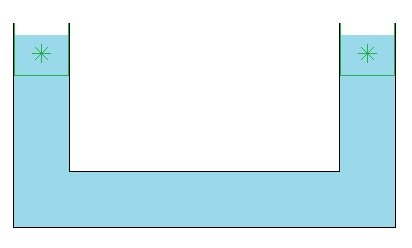
There is a U shaped tube filled with a fluid.
And there are two fluid-filled open-topped flat-bottom boats with paddle wheels inside them at the top of each side of the tube.
[ The fluid inside and outside the boats is the same fluid and the densities of the paddle wheels and the boats are the same as the density of the fluid. ]
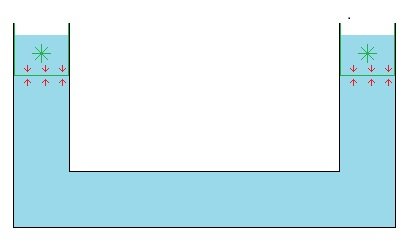
The flat bottoms of the boats have pressure pushing down on them from the fluid above and pressure pushing up on them from the fluid below.

The paddle wheel on the right is set into motion. And so the fluid moves around inside the boat. And so the pressure pushing down on the flat-bottom of the right boat decreases.
The rest of the fluid remains static. And so the pressure pushing up on the flat-bottom of the boat on the right remains the same. And the pressures pushing down and up on the flat-bottom of the boat on the left remain the same.

Both the upward and downward pressures from the fluid on the right decrease. But the tops of the boats are open and so there is not a decrease in upward pressure on the boat on the right. (There is no atmosphere above the two columns of fluid.)

If there is pressure on two sides of a moveable wall, and if there is balance, and then if the pressure on one side of that moveable wall decreases, it seems to me that that wall must move. It cannot not move. (Or, so it seems to me.)

If that is right (if my reasoning is right) then the fluid in the U shaped tube will shift from left to right and the boat on the left will fall while the boat on the right will rise.
What do ya’ think about my question stated this way?
Thank you and cheers. : ) !!!
---

And I suppose there is really no need for the second boat. This would be the same question with just one boat on one side. Since the paddle wheel and the boat are the same density as the fluid and since the fluid in the boat is the same as the fluid outside the boat, then when the paddle wheel is at rest the height of the fluid in the left tube would be the same as the height of the fluid at the top of the boat in the right tube.
Thank you for continuing to consider my question (if I haven’t totally bored you already with this by now : ) ).
0 -
3 hours ago, Genady said:
BTW ...
I think the pressure change stuff I’ve been asking about here is totally different from the proposed perpetual motion machine in the other thread on a mechanical level. But I have been butting up against conservation of energy questions here and all pmms do the same and so I can see the similarities in that aspect. I know most people hate perpetual motion machines, but I love analyzing them. As you know I am self-educated in Physics and so take all that follows with a truck load of salt. And if I’m repeating anything that was already said in the other thread, I apologize. : )
---
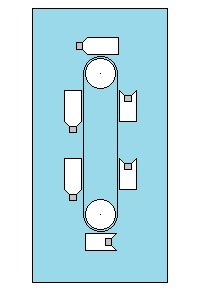
Fascinating perpetual motion machine. I haven’t seen this one before.
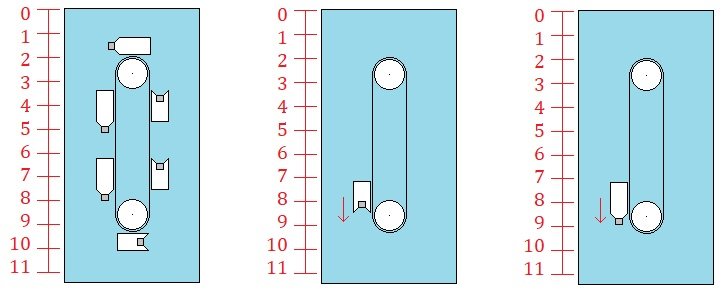
The first thing I noticed about this has to do with the basic idea of “pressure increases with depth”.
The containers either have a vacuum inside or a compressible/decompressible fluid inside. And so after the collapsed containers have reached the bottom and are then on the other side where they expand, when the weight falls and they expand this either creates a larger vacuum or decompresses the fluid inside. It takes energy to either one of these. And this energy comes from the falling weight and the loss of gravitational potential energy.
The point is that the deeper this occurs in the column of fluid the greater the pressure the falling weight has to push back against to create a larger vacuum or more decompressed fluid.
And so, this is a limiting factor. At some depth the pressure will be too great and the force of the weight will not be able to overcome the force from the pressure of the surrounding fluid. And so, sadly if we want this pmm to succeed, this system cannot be made taller and taller and taller. There is limiting factor here.
To counter this we could say the weight could be made heavier and heavier and heavier. And that would work. But that then runs into the second thing I thought about this.
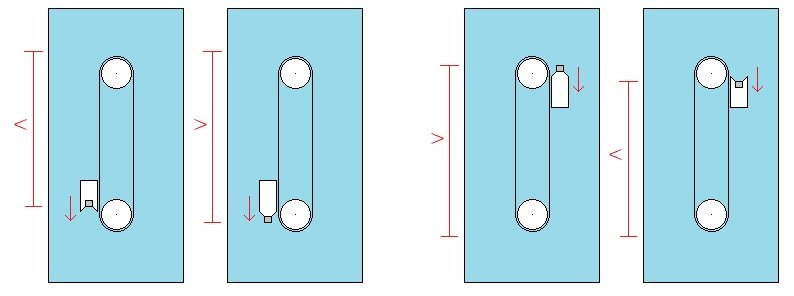
When the weight falls down on the lower left, this means that this weight has to be lifted a longer distance to the top. And it takes more energy to lift a weight a longer distance.
And when the weight falls down the upper right, this means that this weight will move down along this side a shorter distance and so it has less energy to lift the weights up on the other side.
[ When the weight falls down on the lower left side this will impact the system and turn it in the wrong direction while when the weight falls down on the upper right side this will impact the system and turn it in the right direction. And taken together they end up having no net impact. ]
And so returning to the first thing of “pressure increases with depth”, if we make the weights heavier and heavier in order to make this system taller and taller, the heavier the weight the greater the impact these two distance changes (of having to be raised more on the one side and of only getting to move down less on the other side) would have on the system.
And so, sadly if we want this to succeed, another limiting factor.
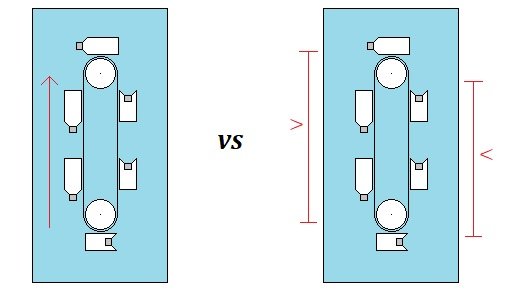
And so it would come down to whether the extra buoyant force turning this clockwise is greater or lesser or equal to the energy needed to raise the weights more than they are lowered.
My guess without having done any calculations is that if we assume no friction then there is probably perfect balance. But just an uncalculated guess.
Take care and cheers. : ) !!!
[ Edit: My uneducated side is showing. I wrote: "And so it would come down to whether the extra buoyant force turning this clockwise is greater or lesser or equal to the energy needed to raise the weights more than they are lowered." And I hope you know what I meant even though this doesn't really make sense. I'm putting up "force" against "energy". I really should have have said something more like "is the clockwise kinetic energy from the extra buoyant force on the right greater or lesser or equal to the energy needed to raise the weights more than they lowered". Ugh! Apologies. : ) !!! ]
1 -
2 hours ago, Genady said:
1. What does happen on the other side of the wheel?

The downward pressure from the fluid decreases when the fluid is in motion and the upward pressure from the fluid decreases when the fluid is in motion (or so I would think).
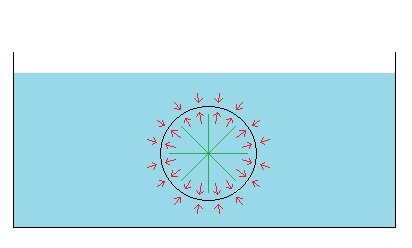
If instead of having a paddle wheel in a boat filled with fluid, we had a paddle wheel in a round submarine filled with fluid, then when the paddle wheel is at rest there would be upward and downward pressures on the walls of the submarine from the fluid inside and from the fluid outside.
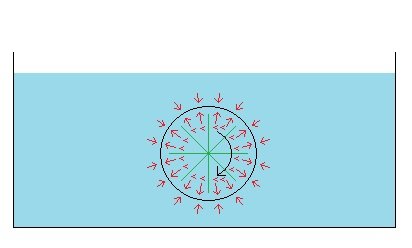
And when the paddle wheel moves the fluid around there would be a decrease in downward pressure on the inside of the sub and there would be a decrease in upward pressure on the inside of the sub.
And so, if the sub was neutrally buoyant when the paddle wheel was at rest, I would suspect that there would be equal decreases in upward and downward pressures and so I would suspect that the sub would also remain neutrally buoyant when the paddle wheel moves.
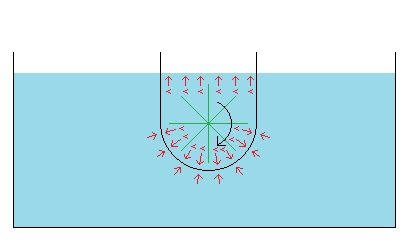
With a boat filled with fluid and an open top and nothing above, if there is a decrease in downward pressure on the boat as the fluid moves around within it, I don't see a decrease in upward pressure on the boat as well (as there was with the water filled sub).
And so I end up with the suspicion that the boat will rise.
2 hours ago, Genady said:2. Consider the following situation. Assume that the fluid inside the boat is sealed. Heat it up. The pressure inside the boat will rise. Will the boat sink?
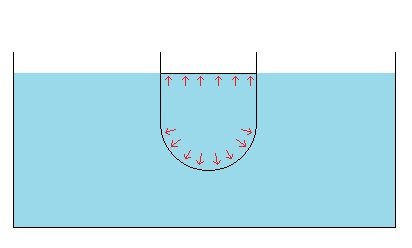
If there is a deck on the boat then there will be downward and upward pressures on the boat from the fluid inside it.
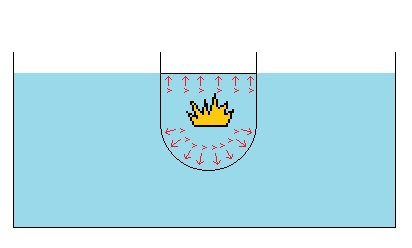
And if that fluid is heated up inside the boat then there will be an increase in downward and upward pressures on the boat from the fluid inside.
And my guess is that like when the fluid moved in the sub and there was a decrease in downward and upward pressures from the fluid inside, that here where there is an increase in downward and upward pressures from the fluid inside that if the boat and its contents were neutrally buoyant when it was cool then it will be neutrally buoyant when it is hot.
---

If
1. The decrease in downward pressure on the bottom of the boat from the fluid inside means a greater overall upward force on the bottom of the boat
While if
2. The decrease in upward pressure from the fluid inside the boat is not on the boat, but is just on the open nothingness above the boat, and so if this does not create a corresponding greater overall downward force on the boat
Then
3. I would expect the boat to rise (and the fluid outside the boat to fall).
And this is why my guess (as of now) is "yes, the boat will rise".
But I'm sure there are lots of things I'm still missing here. And so maybe it won't rise.
Thank you so much for all your insights and help. : ) !!!
0 -
1 hour ago, Genady said:
I say, no. Regardless of what happens inside the boat, the Archimede's principle holds.
Okay, yeah, I wasn't thinking in terms of Archimedes Principle.
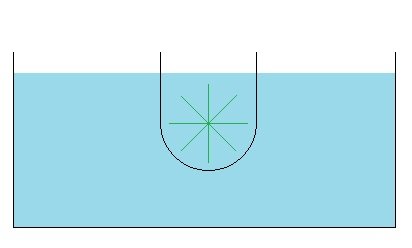
So when the paddle wheel is at rest, and given Archimedes Principle, and given that the density of the boat and the paddle wheel and the fluid in the boat are all the same as the density of the displaced fluid, then there would be no net force in any direction.

Also going on here is there is pressure from the fluid inside the boat pushing down on the boat and there is pressure from the fluid outside the boat pushing up on the boat.

And so my question is: is it possible for the downward pressure on the inside of the boat from the fluid to decrease, and for this to have no effect or no impact on the overall net force in this system?
If there is no effect on the overall net force from this change in pressure, then the boat won't rise. But I have a hard time seeing how this could not have an impact on this system.
Or, perhaps, it does have an impact on this system, but there is also some other physical dynamic than comes into play when the paddle wheel moves the fluid, and this other thing then offsets the impact from the downward decrease in pressure on the inside of the boat, and so that's how the boat does not rise?
Or, something else?
(?) : )
0 -
On 6/12/2023 at 7:55 AM, Genady said:
This was ...
I hope you still have some interest in this. I have a different question but it's related to what we've been talking about here. I was going to just move on from this changing pressure stuff but I've had this other related question that seems makes sense to ask about now and here.
It's the same kinda thing but it's about a possibly vertically moving boat rather than a possibly horizontally moving wall.
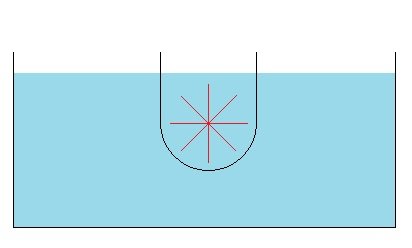
There is a cup of water and a boat. The boat is also filled with water. Submerged in the water in the boat is a paddle wheel. The paddle wheel is fixed in place within the boat but it can rotate around its central axis.
The paddle wheel and the boat are the same density as the fluid (except for the part of the boat above the water line which needs to be hypothetically massless so that the water level inside the boat is the same as the water level outside the boat).
Everything is at rest.
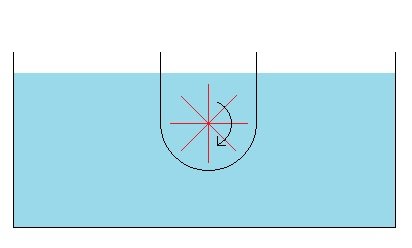
The paddle wheel is then set into motion. And so the paddle wheel moves the fluid around inside the boat. And so the fluid inside the boat moves relative to the inside boat walls while the fluid outside the boat remains at rest.
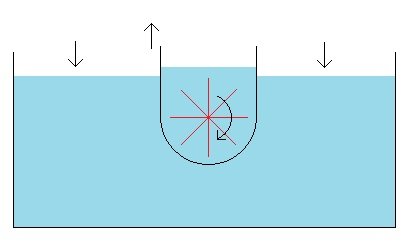
Will the boat rise (while the fluid outside the boat falls)?
My guess is "yes".
[ But, as always, I always seem to ask these questions that seem to me at first to be super simple but then turn out to be very complicated. ]
What do ya' think?
Thank you. : )
[ Edit: If there is an atmosphere fluid pushing down on the top of the water fluid then that might make this more complicated. It, perhaps, might be simpler to think of this thought experiment as happening in a vacuum (?) or maybe not (?) ]
0 -
18 hours ago, Genady said:
z should be equal to y+w rather than greater than.
Yep, I got that part wrong.
18 hours ago, Genady said:each infinitesimal step
I'm guessing you are right and the "infinitesimal steps" of the different movements and shifts would need to be analyzed to resolve the overall process.
Obviously, beyond anything I can do.
Thank you for considering my question and thank you for all of your insights and thank you (especially) for your patience with me. : )
Take care and 'till another time. : ) !!!
0 -
27 minutes ago, Genady said:
You can safely ignore W. It can be, in this ideal experiment, equal zero, because the wall mass doesn't play any role and can be equal 0.
OTOH, the mass of the fluid cannot be zero, because in that case the body would not rise.
Okay. So a massless wall. And so if a massless wall moves then there is no kinetic energy. That makes the thought experiment more simple.
So what I wrote above would need to be changed to " W is the kinetic energy in the fluid moving down and to the right in the left column and up and to the right in the right column " and my analysis still stays the same (?) or no (?)
Thank you. : )
[ Edit: Also, even if the mass of the fluid could be hypothetically 0 in a thought experiment with a rising body (which you said it cannot be), it could not be 0 in this thought experiment because the Z kinetic energy would need a fluid with a mass to try to offset the Y increase in gravitational potential energy. And so, to then be consistent, W would need to include a fluid with a mass. ]
0 -
22 hours ago, Genady said:
Does it make sense?
Yes it does.
And it cuts the right way.
However, its only part of something larger that I overlooked.
And the larger overall aspect cuts the wrong way.
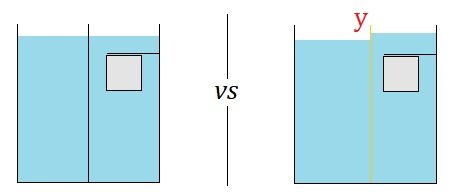
In the the moveable wall case there is an increase in Y amount of gravitational potential energy that does not occur in the non-moveable wall case. And this is part of how I originally framed the question.
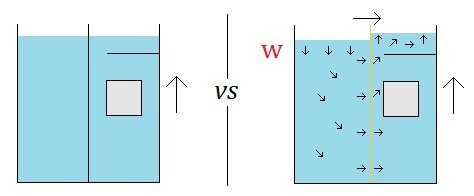
But after reading your last post I realized there was something else I did not include.
When the wall moves, the body of fluid on the left shifts down and to the right and the body of fluid on the right shifts up and to the right and the wall itself moves from left to right.
There is an increase in kinetic energy in the moveable wall case that does not occur in the non-moveable wall case (W).

And this additional kinetic energy in the moveable wall case will end up as as additional thermal energy in the end.
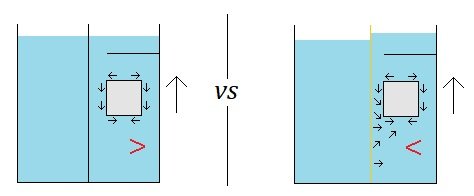
My guess is that your guess is right.
To fill in the gap below the rising body there will probably be more movement of the fluid in the non-moveable wall case than in the moveable wall case since some of the gap below the rising body can be filled in by the fluid displaced by the nearby moving wall. And more movement means more kinetic energy.
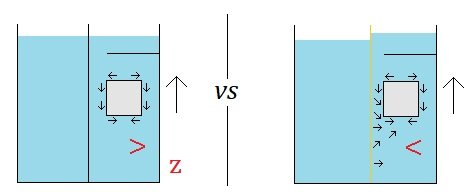
We could call this additional amount of kinetic energy in the non-movable wall case Z amount of kinetic energy.
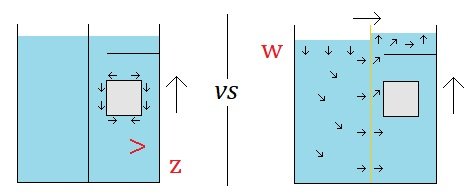
And so the question is: Is Z greater than W or is W greater than Z?

If both rising bodies encounter the same amount of friction as they rise and if both bodies have the same collisions with the barrier wall, then there is same amount of thermal energy (X) in the end in both cases from this.

And then, in the end, in the non-moveable wall case there is more thermal energy from the displaced fluid filling in the gap below the rising body (Z) while, in the end, in the moveable wall case there is more thermal energy from the shifting columns of fluid and the movement of the wall (W).

And, again, there is also an increase in gravitational potential energy in the moveable wall case (Y).

And so, the question is: Is Z greater than Y plus W?
---
My guess is that Z would not be greater than the increase in gravitational potential energy (Y) plus the additional kinetic energy (then turned into thermal energy) from the shifting columns of fluid and moving wall (W).
But, of course and obviously, that is just a guess.
Thank you helping me see an aspect of this question I overlooked before.
But, if my guess is right (and it, of course, may not be) then this cuts the wrong way and points to a greater energy imbalance between the two cases.
Thank you. : )
[ Edit: And I may have missed your point again in your last post. You talked about the fluid moving down with the force of gravity in the non-moveable wall case versus the fluid moving horizontally in the moveable wall case, when it comes to replacing the fluid in the gap below the rising body. And so yes this makes sense to me there would be more kinetic energy, the fluid would be moving faster as it moves with gravity, in the non-moveable wall case. I was thinking in terms of the fluid being more "nearby" the gap below the rising body. It ends up with the same thing, that there is an amount of energy (Z) in the non-moveable wall case that is not present in the moveable wall case. But, I just want to apologize again for my misunderstanding of your replies. Thank you for continuing to consider my question : ) ]
0 -
20 hours ago, Genady said:
The gravitational energy of the higher level of fluid on the right comes from the battery. The rest of the battery energy goes into kinetic energy of the moving fluid and eventually becomes the thermal energy. While without the changing of the level, all the battery energy goes into the kinetic energy and then becomes the thermal energy.
Ah ... I misunderstood your reasoning as to why there would be less fluid moving around the circle in the moveable wall case than in the non-moveable wall case. I'm sorry about that.
If in the moveable wall case, the energy in the battery both circulates the fluid and raises the fluid on the one side of the wall, then I can easily see how this then leads to less thermal energy in the end.
Thank you. : )
---
If you will indulge me a bit further, I'd like to ask about this same question again in the submerged object rising or falling set up.
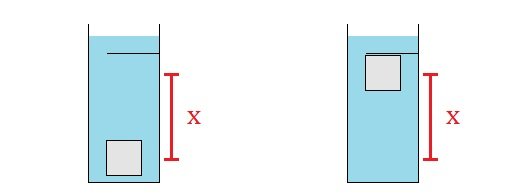
Say there is a submerged less dense body at the bottom of a more dense column of fluid. And say there is a barrier wall that the body can rise to and then come to a stop. And say that the difference in gravitational potential energy between the submerged body at the bottom of the column of fluid and the submerged body at the higher barrier wall is X amount of energy.

Here the middle wall cannot move.
The body starts out at the bottom of the column on the right. It then is allowed to rise. As it rises the surrounding fluid is displaced downwards. And when this happens the fluid moves relative to the middle wall. There is a decrease in pressure on the right side of the middle wall. The unmovable wall does not move. And then the body collides with the barrier wall and comes to a stop.
X amount of gravitational potential energy is gone. (The negative energy becomes less negative.) And due to the friction between the body and the fluid as it rises and due to the collision between the body and the barrier wall, thermal energy is generated. And the amount of thermal energy in the end is X amount of energy.

Now the same things is done again. However this time the middle wall can move from the left to right (but not back again from right to left).
The submerged body is allowed to rise. There is a decrease in pressure on the right side of the middle wall as the fluid is displaced downwards by the rising body. There is then a rightward force on the middle wall due to the difference in pressures on the two sides of the wall. The moveable wall moves to the right. The fluid on the left side of the wall goes down. The fluid on the right side of the wall goes up. (Perhaps by a very small amount, but by some amount.) There is an increase in gravitational potential energy as the left column of fluid goes down and the right column of fluid goes up. Say this increase in gravitational potential energy is Y amount. And the submerged body collides with the barrier wall and comes to a stop. There is an increase in thermal energy from the friction and from the collision.
For energy to be conserved, given that there is an increase in Y amount of potential energy with the increase in height of the column of fluid on the right, this means the increase in thermal energy in the end must be X - Y amount of thermal energy (as in the other set up with the battery and circulating fluid).
There is no battery here and so the increase in Y amount of gravitational potential energy must come from some other greater decrease in energy in the moving wall case that does not occur here in the non-moving wall case.
Does the rising body rise more slowly when the wall moves (as opposed to when the wall does not move)? If that were the case, then the collision between the rising body and the barrier wall would produce less thermal energy. For this to happen the upward buoyant force on the rising body would have to decrease when the wall moves to the right (as opposed to when the wall does not move). I don't think that would happen. But maybe it does and I just don't understand the Physics here. (?) Or something else?
Thank you for continuing to consider my question. : )
0 -
3 hours ago, Genady said:
In the second case, there is a smaller amount of moving fluid to be stopped by friction. This makes a smaller amount of thermal energy.
Thank you for your reply.
When the wall moves to the right versus staying in place, there will be less fluid moving around in the circle but in the narrowing part of the circle this fluid will be moving faster.
----------------
This is what I'm thinking:
An amount of fluid will move around this circle. And in the end, the decrease in X amount of energy in the battery will end up as X amount of thermal energy.
And here a lesser amount of fluid will move around this circle. And in the end the same thing will happen here. The decrease in X amount of energy in the battery will end up as X amount of thermal energy.
----------------
Both of the above systems have smaller sections of "pipe".
The one on the left must end up with overall X amount of energy (since it starts out with X amount of energy in the battery).
And the one on the right must end with with overall X amount of energy as well (since it starts out with X amount of energy in the battery).
But the one on the right also ends up with an increase in gravitational potential energy (Y amount) while the one on the left does not.
If the answer to why there is X - Y thermal energy in the end for the system on the right is that there is a smaller section of "pipe" and so less fluid moving around the circle, then (if I'm thinking logically correctly) that same dynamic would apply to the system on the left and it would end up with X - Y thermal energy (which cannot be the case).
[ It seems like the answer for why there is X - Y thermal energy in the end for the system on the right must come (somehow/someway) from the moving of the wall and the rising of the fluid. (But, as I said, that makes no sense to me.) ]
Or, perhaps, I have just misunderstood the idea and the dynamics at work in what you described. : )
Thank you for replying. : ) !!!
0

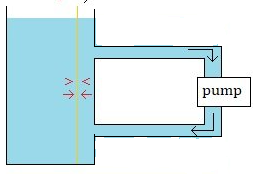




... decrease in pressure ? ...
in Classical Physics
Posted
I'm sorry for having tired you out.
Thank you for your time. : )
Take care. : ) !!!